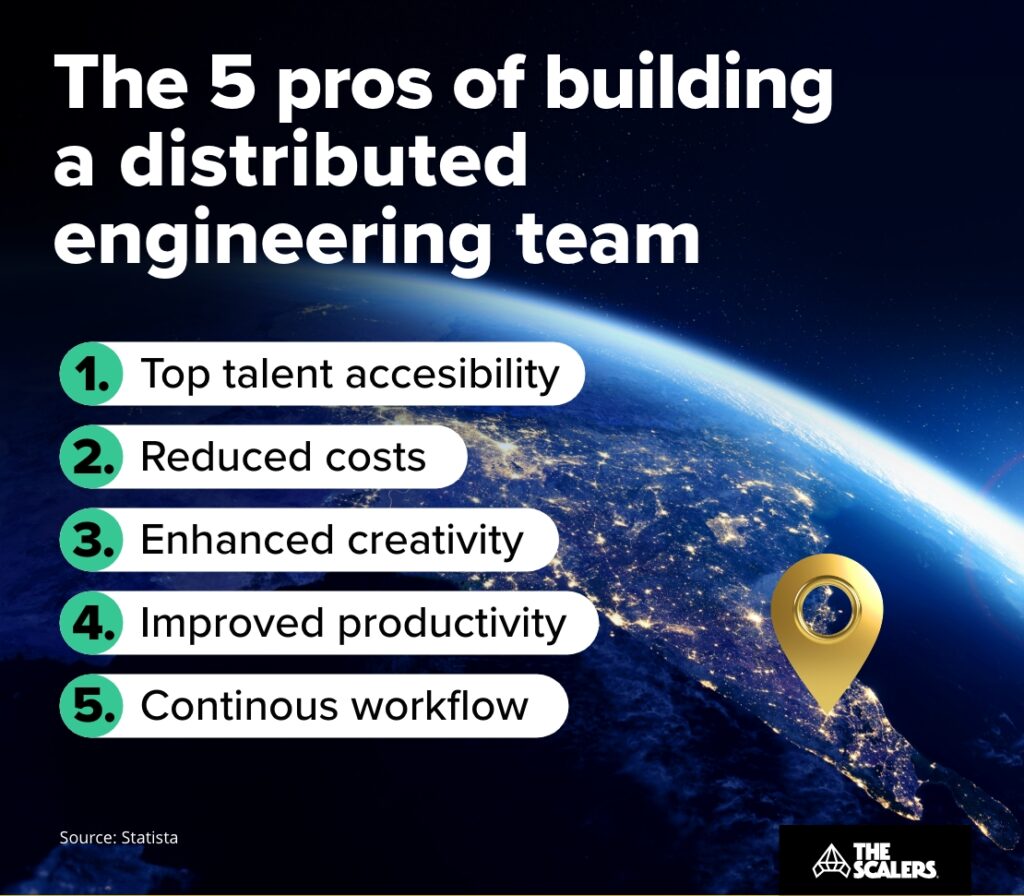Over the last decade, the term ‘distributed engineering teams’ has become increasingly popular, with large tech corporations like Microsoft, GitLab, and Google embracing the benefits of a global workforce.
Today, it’s not just tech giants who employ this operating model. Remote teams have achieved widespread adoption due in no small part to the lockdowns during the COVID-19 pandemic.
But do you (really) need to consider moving from local to distributed engineering teams? If so, how can you navigate such a transition?
In this article, we answer these questions and list the advantages of working with distributed teams. We also discuss the best model for building a dedicated development team in high-talent locations worldwide.
But why should businesses transition from local to distributed teams?
Distributed teams are composed of employees who work from all over the globe and aren’t confined to a single physical headquarters.
Setting up a distributed team can mean hiring freelancers in different countries, engaging with an outsourcing vendor, building a dedicated offshore team, or simply allowing your employees to work from anywhere in the world.
Whatever the case may be, working with distributed teams has its own set of unique advantages. So, for you to justify that it’s the right time and the right move for your business, ask yourself the following questions:
- Are you struggling to find the right local talent?
- Do you believe that your existing team displays insufficient technical and soft skills?
- Are you paying an absolute premium to stay local?
- Are you scaling at an incredibly slow pace?
- Are you struggling to focus on the core competencies of your business?
If the answers to the above questions are ‘yes’, then building a distributed engineering team can be highly beneficial for your business.

What are the advantages of building a distributed engineering team?
These are the five main advantages of the distributed team model.

Access to the best talent anywhere in the world
When building a distributed team, you can count on talent located in different locations and time zones to your headquarters. This means you can collaborate with top professionals in thriving hubs like Bangalore, India.
With no geographical limitations to where you can search, find, and hire engineers, assembling an A-team is more likely than doing it at home.
The Western tech talent scarcity in countries like the US — where the U.S. Bureau of Labor Statistics confirms that the shortage of available talent will grow to 1.2 million by 2026 — is a headache for CTOs and other tech leaders.
Distributed teams are a solution to such shortages.
Get more from your tech budget
Transitioning from local to distributed teams comes with a significant cost reduction. Just think about it: an engineer in Eastern Europe or Southeast Asia earns a fraction of what their UK, US, or Australian counterparts earn.
For instance, a software engineer in the US earns a median salary of $175,000/year, while an equivalent engineer in Poland earns $62,400/year.
Distributed teams are known for being cost-effective, given the value per cost organisations get when hiring highly qualified talent abroad. You can save on office expenses and equipment and count on some of the world’s most talented engineers.
However, prioritising the cheapest option may not guarantee excellence. Make sure you balance cost-effectiveness and quality when hiring engineers abroad.
Promote creativity and face challenges better
Working with people from different cultures and backgrounds is a recipe for greater innovation.
It’s a matter of embracing diversity.
If your engineering team is formed by professionals who think alike, it can restrict creativity and present challenges in addressing issues when facing challenges like tackling technical debt.
If you work with professionals from different countries, you’ll bring fresh perspectives that locals might miss and new points of view to solve old-age problems.
Plus, you can access niche programming skills you couldn’t at home.
Improve your team’s productivity
Contrary to popular belief, distributed teams are the same or more productive than local in-house teams.
Indeed, Cisco Global Hybrid Work Study 2022 showed that 61% of employees believed their quality of work had improved, with a similar proportion (60%) feeling the same about their productivity.
Engineers tend to feel more satisfied when working in a distributed setup, and tech leaders feel it promotes greater flexibility and collaboration.
Keep operations rolling 24/7
Building distributed engineering teams means enjoying 24/7 operations. When your team in your New York, London, or Amsterdam headquarters logs off, your engineers in India or The Philippines are about to start their day.
This allows you to keep operations and processes running while you sleep. Literally.
See Colmore, one of our renowned partners.
We built a distributed team via offshoring that helped them process data faster and have it ready when their clients in the US woke up in the morning.
Choosing the right engagement model
Now that you know the pros of building distributed teams, it’s time you choose the engagement model that best suits your needs.
Freelancers
Working with freelancers globally is one of the easiest ways to assemble a team.
While this is a fairly straightforward model, it’s important to remember that the people you hire don’t ‘belong’ to your organisation. They’re hired on a contract basis and work for many different clients at any given time. This can lead to a lack of customer focus, low-quality work, stretched timelines, and more chaos than initially anticipated.
Outsourcing
Outsourcing, a common engagement model, involves working with an outsourcing partner to hire individuals for specific projects. However, neither the partner nor the hired individuals are directly employed by you. While suitable for short-term projects requiring additional capacity, it lacks sustainability in the long run due to the absence of team ownership.
Nearshoring
Nearshoring allows companies to hire talent in neighbouring countries.
For example, developers in Paris may be expensive, so French-based tech leaders may consider nearshore alternatives like hiring developers in Romania. These developers work in a similar time zone but at a lower cost.
Therefore, nearshoring is ideal for companies seeking continuous, real-time collaboration with engineers near home.
Offshoring
The offshoring model — with its traditional and offshoring 2.0 approaches — has gained significant popularity among businesses looking to build distributed teams. This engagement model allows organisations to build a dedicated team of skilled employees in countries with a massive talent pool, such as India.
When you offshore software development, you are building a team of permanent, full-time employees, just like your local team, except that they’re based elsewhere.
Choosing the right location
Building a distributed team allows you to gain access to exceptional talent without the sky-high prices of hiring locally. Especially if you decide to choose offshoring as your engagement model.
But how can you choose the right destination?
Here are our top picks:
1. India
Also known as the IT offshoring capital of the world, India is one of the fastest-growing tech hubs today. With a massive talent pool, skilled developers, and a large English-speaking population, India tops the list of the best destinations to build a distributed team.

2. The Philippines
Today, more and more IT-based products and services are being built in The Philippines. Once known for its booming BPO industry, the country is now establishing a strong foundation in the IT space by producing advanced applications integrated with the latest technology, such as Artificial Intelligence and Machine Learning.
3. Eastern Europe
For businesses operating in Western Europe, nearshoring to Eastern European countries is a lucrative option. Though countries like Poland and Romania have fewer developers than tech hubs like India, businesses can still find skilled talent at lower prices than hiring locally in countries like the UK.
In summary
Distributed teams are far from being a post-COVID trend, with organisations and employees benefiting from more flexible workplaces.
As a CTO, VP of Engineering, or other business leader, leveraging the vast talent pools in global tech hubs provides excellent opportunities for growth and innovation.
Key takeaway
-
1
Building distributed engineering teams gives access to top talent globally, overcoming geographical limitations and addressing talent shortages in countries like the US.
-
2
Transitioning to distributed teams can help maximise tech budgets, as talent in regions like Eastern Europe or Southeast Asia often commands lower salaries compared to Western counterparts.
-
3
Working with professionals from diverse backgrounds enhances creativity and innovation within engineering teams, offering fresh perspectives and niche skills.
-
4
Distributed teams can be as productive as, or even more productive than, local in-house teams, with studies showing work quality and productivity improvements.
-
5
Operating with distributed teams enables continuous workflow with 24/7 operations, leveraging time zone differences to maintain productivity around the clock.
-
6
Choosing the right engagement model is crucial, whether freelancers, outsourcing, nearshoring, or offshoring. Each has advantages and drawbacks.
-
7
Selecting the optimal location for building a distributed team is essential. Regions like India, the Philippines, and Eastern Europe offer skilled talent at lower costs, providing businesses with opportunities to optimise resources effectively.
So, are you ready to build a distributed team? At The Scalers, we specialise in finding, hiring, onboarding and engaging world-class engineering teams in Bangalore, India, ‘The Silicon Valley of Asia’.
If you want to know more about our unique and proven model, fill out this form, and one of our senior executives will get back to you shortly.
Build Your Team,
Not Just a Contract
With The Scalers’ offshore dedicated development team, you get engineers who join your workflow for the long run. Grow steadily, stay flexible, and work with people who care about the product as much as you do.








